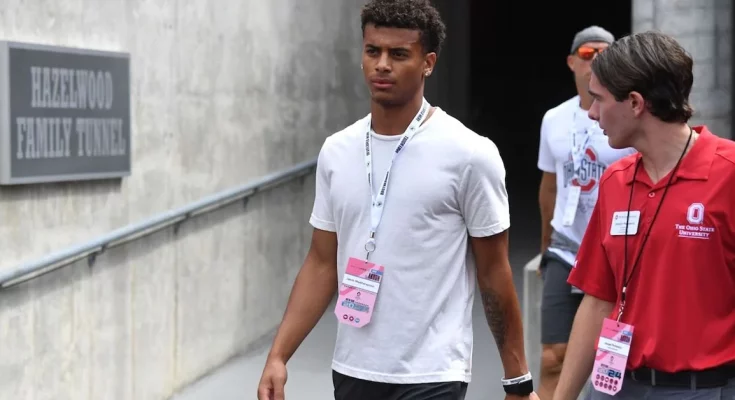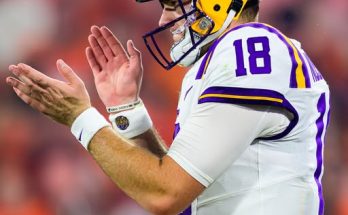Jakob Weatherspoon’s decision to flip his commitment from Ohio State to the University of North Carolina sent ripples throughout the college football recruiting landscape. As a 4-star safety and one of the top defensive backs in the 2025 class, Weatherspoon’s recruiting journey has been followed closely by analysts and fans alike. At a time when college football recruiting is as dynamic and fluid as ever—especially with the transfer portal, NIL, and new NCAA regulations redefining how programs build their rosters—Weatherspoon’s commitment flip carries weight not just in the context of these two programs, but as a microcosm of larger trends shaping modern college football.
Weatherspoon, a native of Lawrenceville, Georgia, had long been on the radar of top-tier Power Five programs. Standing 6-foot-1 and weighing just over 190 pounds, his physical profile matches the prototype for a modern safety: rangy, fast, and physical. His junior year at Central Gwinnett High School showcased his athleticism, versatility, and football IQ. With over 60 tackles, multiple interceptions, a handful of pass deflections, and some special teams highlights, Weatherspoon was quickly pegged as one of the top safeties in the Southeast.
Ohio State had been one of the earliest programs to aggressively pursue him. They offered him before the end of his sophomore year, and he visited Columbus multiple times, developing a relationship with then-defensive backs coach Tim Walton and head coach Ryan Day. For several months, the Buckeyes appeared to be in total control of his recruitment. In fact, his verbal commitment in late March of this year seemed to solidify what many believed would be a done deal: another elite DB headed to the Big Ten powerhouse.
But recruiting is rarely so simple.
Behind the scenes, a convergence of factors began to shift Weatherspoon’s thinking. The departure of Tim Walton from Ohio State to the NFL in late spring left a vacuum in the Buckeyes’ secondary coaching room. While new staffers were brought in quickly and the transition was handled professionally, it disrupted some of the continuity and trust that had been built up during the recruiting process. Though Weatherspoon publicly expressed confidence in the new staff, privately, those close to him noted a drop-off in communication and comfort level.
Meanwhile, North Carolina had never stopped recruiting him. Dre Bly, former NFL Pro Bowler and now one of the most respected secondary coaches in the ACC, had identified Weatherspoon early as a top priority. UNC’s pitch had always emphasized fit—not just on the field, but culturally and academically. Chapel Hill’s location closer to Weatherspoon’s family, its academic prestige, and the program’s emphasis on developing players for the next level all became increasingly appealing.
But what truly changed the trajectory of Weatherspoon’s recruitment was the summer visit to Chapel Hill in June. Unlike the earlier unofficials, this visit was more in-depth, structured around a personal experience. He got to sit in on defensive meetings, observe drills during summer workouts, spend time with players from UNC’s current defensive backfield, and speak directly with Mack Brown about his vision for the program. According to several sources, Weatherspoon left that visit feeling that North Carolina offered him a clearer, more personal path to success than Ohio State.
Another major factor in the flip was NIL. While Weatherspoon and his family have never made monetary compensation a public sticking point, it’s no secret that in this era of Name, Image, and Likeness, recruits are considering what kind of support structure schools can offer beyond scholarships. Ohio State, with its vast donor base and national reach, certainly has one of the strongest NIL platforms in the country. But in recent months, North Carolina has quietly made significant strides, particularly through its Heels4Life collective, which focuses on responsible, athlete-centered support rather than headline-grabbing deals.
For Weatherspoon, it wasn’t about the biggest bag; it was about sustainability, community involvement, and the ability to grow a personal brand authentically. At UNC, he saw a university and a football program working in tandem to create opportunities both on and off the field. Whether it was local endorsement opportunities, community engagement, or media training, the holistic support North Carolina could provide started to resonate more deeply with him.
Football-wise, the fit at North Carolina is compelling. The Tar Heels run a 4-2-5 base defense that relies heavily on versatile safeties who can cover deep, support the run, and occasionally roll down into the slot. Weatherspoon’s skillset—long arms, quick hips, and elite acceleration—makes him ideal for this kind of hybrid role. He thrives in man coverage but also understands zone responsibilities and isn’t afraid to come downhill to make a tackle. With UNC’s recent struggles on defense, especially in pass coverage, his arrival signals a shift toward building a more athletic, disciplined secondary.
It’s also worth noting that North Carolina’s 2025 class has quietly been climbing the rankings. With multiple blue-chip recruits already committed, Weatherspoon’s addition provides both talent and momentum. His flip also serves as a symbolic win over Ohio State—a program known for poaching talent from across the country—and could encourage other undecided recruits to give UNC a harder look. In the world of recruiting optics, perception can become reality. And the perception now is that North Carolina is capable of competing toe-to-toe with national brands.
For Ohio State, this loss stings, but it’s not necessarily catastrophic. The Buckeyes continue to stockpile talent in the secondary and still hold commitments from other highly-rated defensive backs. But losing a player like Weatherspoon, especially after such a long pursuit and verbal commitment, raises questions about staff continuity, communication, and the effectiveness of recruiting follow-up once players are verbally locked in. In today’s environment, where commitments are more fluid than ever, programs must continue to re-recruit their own pledges until signing day.
Jakob Weatherspoon’s flip also speaks to a broader cultural and strategic shift in college football recruiting. No longer are the top 20 or so programs the only serious destinations for elite talent. With NIL, coaching hires, and customized recruiting strategies, programs like North Carolina are gaining ground in ways that were nearly impossible a decade ago. The democratization of exposure—through social media, streaming, and digital media—means that players no longer need to go to perennial bluebloods to become household names or NFL Draft prospects.
Furthermore, this decision underlines the importance of fit over prestige. Weatherspoon could have played at Ohio State, joined a historically elite DB room, and competed for Big Ten titles annually. But at North Carolina, he may be able to make a more immediate impact, develop under a position coach he trusts deeply, and be part of a narrative that’s still being written. There’s something powerful about choosing to be a cornerstone rather than just another brick in an already-built foundation.
His story also serves as a lesson to young recruits and their families: take your time. Relationships matter. Don’t stop evaluating programs just because you’ve made a verbal commitment. Coaching staffs can change. Schemes can evolve. NIL infrastructure can shift. What’s true in January may not be true in July. The best programs understand this and support the decision-making process rather than pressure players into quick commitments.
For Tar Heel fans, this is a moment of validation. It shows that the Mack Brown experiment, now several years in, is starting to yield high-level recruiting results. It also shows that UNC isn’t just a basketball school—it’s building a legitimate, sustainable football identity. Weatherspoon’s arrival is more than just a depth chart adjustment; it’s a statement of intent.
Jakob Weatherspoon will now enter his senior year of high school as one of the most high-profile defensive backs in the country. He’ll face intense scrutiny on the field, but if his previous performances are any indication, he’s built for the spotlight. What happens next in his journey will depend on continued development, staying healthy, and adapting to the collegiate level of play. But if his decision-making process is any reflection of his football instincts, then North Carolina fans should be excited about what’s to come.
College football recruiting will always have its drama—flips, decommitments, last-minute changes—but occasionally, a storyline like Weatherspoon’s gives fans a deeper appreciation for the human element behind the stars and rankings. These are teenagers making life-altering decisions in a rapidly evolving environment. The best they can do is surround themselves with people they trust, ask the hard questions, and follow the path that aligns with who they are and who they want to become.
In choosing North Carolina, Jakob Weatherspoon didn’t just make a recruiting move—he made a life decision. One that will be judged not by stars on a website, but by the impact he makes on the field, in the locker room, and in the community. Whether he becomes an All-ACC safety, an NFL Draft pick, or something even greater, his story will always be tied to the moment he chose Chapel Hill over Columbus—not because it was the obvious path, but because it was the right one for him.



